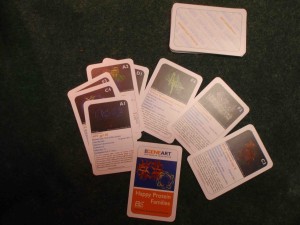Breeze by the cosmetics section of the department store next time. There is a 1+ billion-dollar market being bought and sold right under, and on top of, everyone’s noses, using mostly experimental organic chemistry, wrapped up in advertisements of sexualizing, anti-aging, softening, cleansing, wrinkle-reducing, organic, non-animal tested, oil-free, oil-reducing, oil-enhancing, whitening, darkening, clarifying, and most of all, “all natural”.
The cosmetics industry seems ripe for synthetic biology chemical factory creation. A short list of ingredients in skin care products, as some examples, are below (disclaimer: quoted from wikipedia). Many of these ingredients do have supposed medicinal properties.. some are questionable.
Witch Hazel
Witch hazel is an astringent produced from the leaves and bark of the North American Witch Hazel shrub (Hamamelis virginiana) which ranges from Nova Scotia west to Ontario, and south to Florida, and Texas[1]. This plant, native to Canada and the United States was widely used for medicinal purposes by American Natives. The witch hazel extract was obtained by steaming the twigs of the shrub.
The essential oil of witch hazel is not sold separately as a consumer product. The plant does not produce enough essential oil to make production viable. However, there are various distillates of witch hazel (called hydrosols or hydrolats) that are gentler than the “drug store” witch hazel and contain alcohol.
Now for a PubMed article:
Highly galloylated tannin fractions from witch hazel (Hamamelis virginiana) bark: electron transfer capacity, in vitro antioxidant activity, and effects on skin-related cells, Touriño S, Lizárraga D, Carreras A, Lorenzo S, Ugartondo V, Mitjans M, Vinardell MP, Juliá L, Cascante M, Torres JL. Chem Res Toxicol. 2008 Mar; 21(3):696-704. Epub 2008 Mar 1.
Institute for Chemical and Environmental Research (IIQAB-CSIC), Jordi Girona 18-26, 08034 Barcelona, Spain. PMID: 18311930
Witch hazel ( Hammamelis virginiana) bark is a rich source of both condensed and hydrolizable oligomeric tannins. From a polyphenolic extract soluble in both ethyl acetate and water, we have generated fractions rich in pyrogallol-containing polyphenols (proanthocyanidins, gallotannins, and gallates). The mixtures were highly active as free radical scavengers against ABTS, DPPH (hydrogen donation and electron transfer), and HNTTM (electron transfer). They were also able to reduce the newly introduced TNPTM radical, meaning that they included some highly reactive components. Witch hazel phenolics protected red blood cells from free radical-induced hemolysis and were mildly cytotoxic to 3T3 fibroblasts and HaCat keratinocytes. They also inhibited the proliferation of tumoral SK-Mel 28 melanoma cells at lower concentrations than grape and pine procyanidins. The high content in pyrogallol moieties may be behind the effect of witch hazel phenolics on skin cells. Because the most cytotoxic and antiproliferative mixtures were also the most efficient as electron transfer agents, we hypothesize that the final putative antioxidant effect of polyphenols may be in part attributed to the stimulation of defense systems by mild prooxidant challenges provided by reactive oxygen species generated through redox cycling.
That doesn’t mean everyone should go rubbing witch hazel all over themselves.. though it does show that witch hazel does “something.”
Triclosan
Triclosan (IUPAC name: 5-chloro-2-(2,4-dichlorophenoxy)phenol) is a potent wide spectrum antibacterial and antifungal agent. Triclosan is found in soaps (0.15-0.30%), deodorants, toothpastes, shaving creams, mouth washes, and cleaning supplies and is infused in an increasing number of consumer products, such as kitchen utensils, toys, bedding, socks, trash bags, and some Microban treatments. Triclosan has been shown to be effective in reducing and controlling bacterial contamination on the hands and on treated products. More recently, showering or bathing with 2% triclosan has become a recommended regimen for the decolonization of patients whose skin is carrying methicillin resistant Staphylococcus aureus (MRSA)[1] following the successful control of MRSA outbreaks in several clinical settings.
Horsetail Extract
What! Yes, it says “Horsetail Extract” on the container. Though I didn’t find this as a real ingredient in wikipedia, I found it in the following patent.
United States Patent 5415861
Abstract: A method for reducing the visible size of facial skin pores by applying a novel composition which comprises an oil absorbing powder, a botanical astringent and a biological compound that alters the structure of the skin and/or the function of the sebaceous glands. […]
Horsetail extract (Equisetum arvense) is a preferred compound because it contains significant amounts (>8%) of organic silicones. These silicones are known to regulate collagen cross linking and improve the structural framework of connective tissues in the skin. Like the alternative compositions, Horsetail extract functions on and below the skin surface to reduce pore size with regular application.
Camellia Sinensis Leaf
Camellia sinensis is the tea plant, the plant species whose leaves and leaf buds are used to produce tea. It is of the genus Camellia (Chinese: 茶花; pinyin: Cháhuā), a genus of flowering plants in the family Theaceae. White tea, green tea, oolong and black tea are all harvested from this species, but are processed differently to attain different levels of oxidation. Kukicha (twig tea) is also harvested from camellia sinensis, but uses twigs and stems rather than leaves.
- The leaves have been used in traditional Chinese medicine (TCM), and other medical systems to treat asthma (functioning as a bronchodilator), angina pectoris, peripheral vascular disease, and coronary artery disease.
Tea extracts have become field of interest, due to their notional antibacterial activity. Especially the preservation of processed organic food and the treatment of persistent bacterial infections are being investigated.
- Green tea leaves and extracts have shown to be effective against bacteria responsible for bad breath.
- The tea component epicatechin gallate is being researched because in-vitro experiments showed that it can reverse methicillin resistance in bacteria like Staphylococcus aureus. If confirmed, this means that the combined intake of a tea extract containing this component will enhance the effectiveness of methicillin treatment against some resistant bacteria.
An amazing aspect of cosmetics is the historical basis for many of the ingredients, many of them in use for hundreds or thousands of years.


